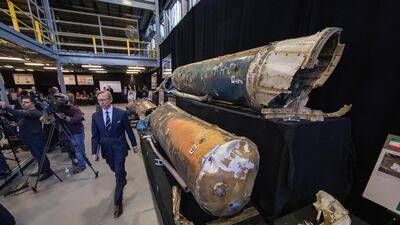The latest display of Iranian weapons accumulated from various battlefronts in the Middle East where Tehran's forces are engaged can leave no one in any doubt about the grave risk the regime poses to the region's security.
One of the fundamental principles of Iran’s 1979 Islamic Revolution was that the regime is committed to exporting its controversial form of Islamic government throughout the Muslim world.
In particular, the Iranians are keen to expand their leverage in the Arab world, particularly in those countries, such as Iraq and Bahrain, which have significant Shia populations.
Now, any doubts critics might have entertained about the scale of the threat Iran poses will have been answered by the disturbing array of weaponry on display in Washington.
One of the main reasons the Trump administration has taken a hard line with Iran over the controversial nuclear deal is Washington’s concerns about Iran’s continued meddling in the affairs of neighbouring states.
The administration argues that if Iran is really serious about complying with the spirit of the nuclear deal it negotiated with former US president Barack Obama in 2015, then it would not be funding and supporting aggressive military operations in countries like Syria, Lebanon, Iraq and Yemen.
Iran has consistently denied any wrongdoing. In Yemen, for example, where attempts to get peace talks underway appear to be making progress in Stockholm, Tehran has repeatedly denied having any military involvement.
Now, the evidence produced in Washington by David Hook, the US special representative for Iran, resoundingly proves otherwise, showing that, far from having nothing to do with conflicts in places such as Yemen, the Iranians are one of the main suppliers of the weaponry that has resulted in a major military escalation in the country’s civil war.
The weaponry put on display included Sayyad-2C surface-to-air missiles, AK47s and smaller arms, as well as the debris of a drone said to have been used in the Yemen conflict.
Details of bomb-making equipment used by terrorist groups to try to destabilise the government in Bahrain were also on display. The main focus of Mr Hook's presentation, though, was the destabilising effects of meddling in Yemen, Iraq and Syria were having on the region. He also highlighted Iran's lesser-known – in some western capitals, at least – involvement in the long-running Afghan conflict.
And he gave a stark warning that the level of Iran’s aggressive military involvement in these various conflicts had now reached the point where one false move could provoke an all-out regional war.
“We are one missile attack away from a regional conflict,” said Mr Hook. The supply of Iranian missiles to Houthi rebels, such as the one recently used in the attack on Riyadh international airport, was “increasing the lethality and reach of these weapons to deepen its presence throughout the region. The same kind of rockets here today could tomorrow land in a public market in Kabul or at an international airport,” he said.
Mr Hook also highlighted the administration’s growing concern about Iran’s increased involvement in Iraq, where Tehran has recently intensified its support for militias who are trying to undermine the country’s recently appointed prime minister Abdul Mahdi, a pragmatist who is said to be resisting attempts to influence government policy.
One of Washington's main concerns, said Mr Hook, was "credible US evidence that Iran is transferring ballistic missile technology to Shia militias in Iraq."
Another concern, one that has recently been raised by British military officials working in Iraq, is Iran’s increased use of Shia hit squads in Iraq to silence critics of meddling in the country.
The most high-profile victim to date has been Adel Shaker Al Tamimi – a close ally of former Iraqi prime minister Haider Al Abadi – who is said to have been assassinated by the Quds force in September.
A Shia Muslim and joint Canadian-Iraqi national, Al Tamimi, 46, was involved in attempts in Baghdad to heal the schism between the country's Shia and Sunni communities and also worked as a low-key envoy between Iraq and neighbouring Arab states, such as Jordan and Saudi Arabia.
There is also compelling evidence that assassins have targeted opponents across Iraq’s political spectrum.
Other victims of hit squads are said to include Shawki Al Haddad, a close ally of the Shia firebrand Moqtada Al Sadr, a former protege of Tehran who recently adopted a more nationalist agenda.
Al Haddad was murdered in July after accusing the Iranians of election fraud. Meanwhile Rady Al Tai, an adviser to Ayatollah Ali Al Sistani, Iraq's leading Shia cleric, was the subject of a failed assassination attempt in August after he called for a curbing of outside influence on the new government.
Earlier this week the US House of Representatives passed a bill designed to target Iran’s support for Iraqi militias. But as the latest evidence of malign meddling in the region shows, far stronger measures might be required to persuade Tehran to mend its ways.
Con Coughlin is the Daily Telegraph’s defence and foreign affairs editor


